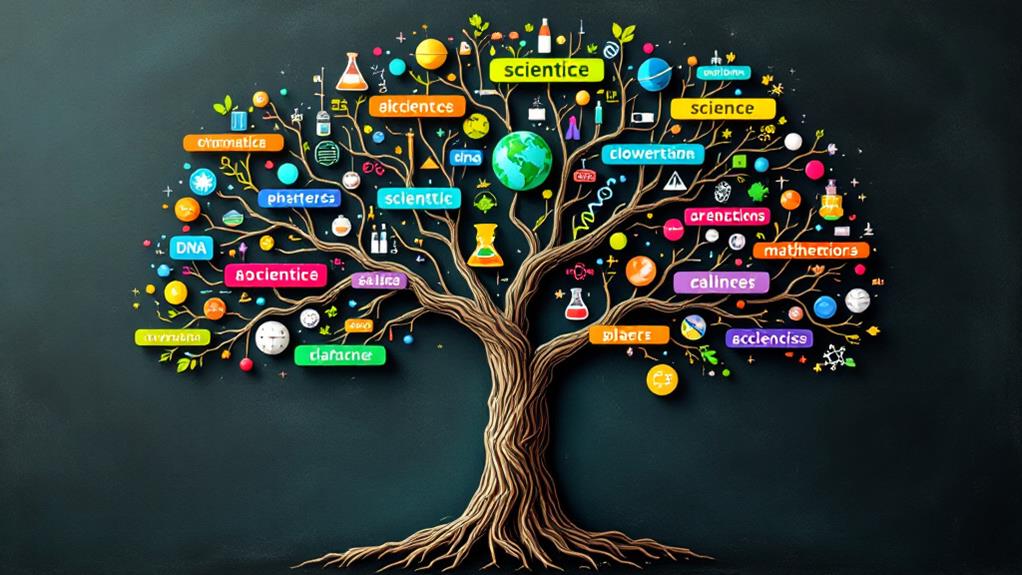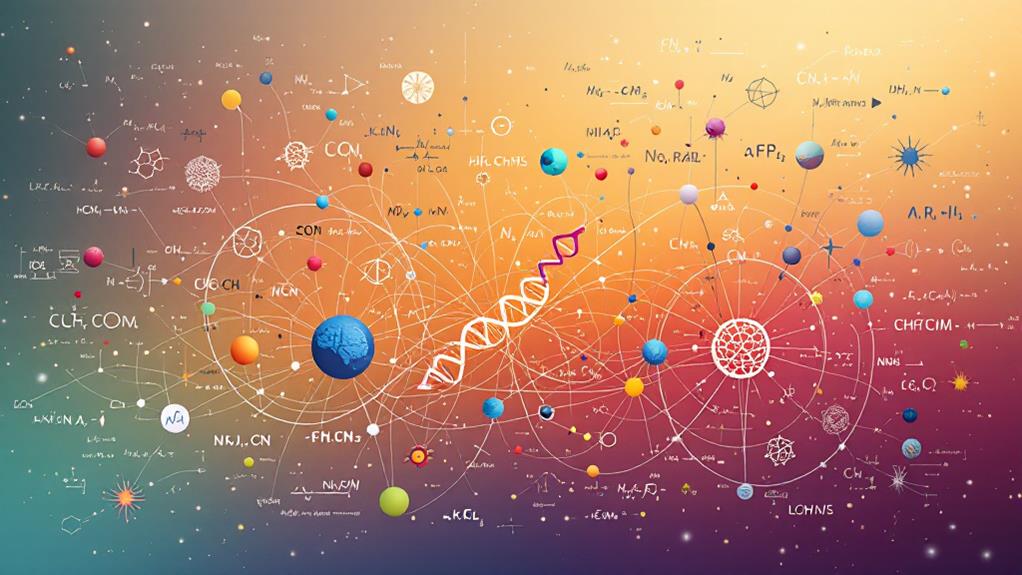The Branches of Science Explained: What You Need to Know

Science is divided into several major branches, each exploring different aspects of our world. You'll find physical sciences like physics and chemistry, which study matter and energy. Life sciences, including biology and genetics, focus on living organisms. Earth and environmental sciences examine our planet and ecosystems. Social sciences investigate human behavior and society. Formal sciences, such as mathematics and computer science, deal with abstract systems. Applied sciences use scientific knowledge to solve real-world problems. Finally, interdisciplinary fields combine multiple scientific domains. By understanding these branches, you'll gain a detailed view of how science helps us comprehend and shape our world.
Physical Sciences
Within the domain of physical sciences, you'll find disciplines that investigate the fundamental nature of matter, energy, and their interactions. These fields encompass a wide range of studies, from the tiniest subatomic particles to the vast expanse of the universe.
Physics, the cornerstone of physical sciences, probes the basic principles governing the natural world. It's divided into various branches, including mechanics, which deals with motion and forces, and thermodynamics, which studies heat and energy transfer. Chemistry, another pivotal physical science, focuses on the composition, structure, and properties of matter, as well as the changes it undergoes during reactions.
Astronomy and astrophysics examine celestial objects and phenomena, while earth sciences like geology and meteorology investigate our planet's structure and atmosphere. Materials science bridges physics and chemistry to study the properties of various substances.
In recent years, interdisciplinary fields like biophysics and geochemistry have emerged, combining principles from multiple physical sciences to tackle complex problems. As you immerse yourself in these disciplines, you'll uncover how they interconnect and contribute to our understanding of the physical world.
Life Sciences
Diving into the domain of life sciences, you'll encounter disciplines that investigate the intricate workings of living organisms. This field encompasses a wide range of subjects, from the microscopic to the macroscopic, all focused on understanding life in its various forms.
Biology, the cornerstone of life sciences, probes the structure, function, growth, and evolution of living things. Within biology, you'll find specialized areas like genetics, which studies heredity and gene expression, and ecology, which examines the interactions between organisms and their environment.
Molecular biology and biochemistry delve deeper, investigating molecular structures and cell metabolism. These fields help us understand how cells function at the most fundamental level, laying the groundwork for advancements in medicine and biotechnology.
Zoology and botany focus on the animal and plant kingdoms, respectively, while microbiology examines microscopic life forms like bacteria and viruses. Other important branches include physiology, which studies bodily functions, and neuroscience, which explores the nervous system and brain.
Earth and Environmental Sciences

From the depths of the ocean to the upper reaches of the atmosphere, Earth and environmental sciences investigate our planet's complex systems. These fields encompass a wide range of disciplines, including geology, oceanography, meteorology, and ecology. They aim to understand how Earth's systems interact and evolve over time.
As an Earth scientist, you'll study the planet's structure, composition, and processes. You might analyze rock formations, investigate plate tectonics, or examine the Earth's magnetic field. Environmental scientists focus on the interactions between living organisms and their surroundings, inspecting ecosystems and biodiversity.
Climate change impacts are a critical area of study in these fields. You'll research how rising temperatures affect weather patterns, sea levels, and ecosystems. This knowledge is essential for developing strategies to mitigate and adapt to climate change.
Sustainable resource management is another key focus. You'll work on finding ways to balance human needs with environmental conservation. This includes developing renewable energy sources, improving water management, and creating sustainable agricultural practices. By understanding Earth's systems, you'll contribute to solving some of our planet's most pressing challenges.
Social Sciences
At the intersection of human behavior and society, social sciences investigate how individuals and groups interact, function, and evolve. This diverse field encompasses various disciplines that plunge into different aspects of human life and societal influences.
Psychology probes into the human mind, examining thoughts, emotions, and behaviors. Sociology focuses on social structures, institutions, and cultural dynamics that shape communities. Anthropology studies human cultures across time and space, while economics analyzes how societies allocate resources and make decisions.
You'll find that political science examines power structures, governance, and policy-making processes. Meanwhile, human geography explores the relationship between people and their environments. These disciplines often overlap and complement each other, providing a comprehensive understanding of human societies.
Social sciences employ research methods like surveys, experiments, and ethnographic studies to gather data and test theories. They aim to uncover patterns and explain social phenomena, helping you understand the complex web of human interactions and societal influences that shape our world.
Formal Sciences

While social sciences investigate human behavior and society, formal sciences take a different approach, focusing on abstract systems and logical structures. These disciplines provide the foundation for other scientific fields by developing tools and methods for analyzing complex problems.
Formal sciences include mathematics, statistics, computer science, and theoretical linguistics. They rely heavily on formal logic and mathematical modeling to create frameworks for understanding and solving abstract problems. Unlike natural sciences, formal sciences don't depend on empirical observations but instead use deductive reasoning to reach determinations.
In mathematics, you'll find fields like algebra, geometry, and calculus, which provide essential tools for other scientific disciplines. Statistics offers methods for collecting, analyzing, and interpreting data, vital for research across various fields. Computer science explores algorithms, data structures, and computational theory, driving technological advancements.
Formal sciences contribute to other scientific branches by providing rigorous methods for problem-solving and data analysis. They help scientists in other fields develop hypotheses, design experiments, and interpret results. By gaining proficiency in formal sciences, you'll acquire powerful tools for tackling complex problems in any scientific discipline.
Applied Sciences
Applied sciences bridge the gap between theoretical knowledge and practical applications. These fields focus on using scientific principles to solve real-world problems and create innovative solutions. You'll find applied sciences in various industries, from engineering and technology to healthcare and agriculture.
When exploring applied sciences, you'll encounter disciplines that directly impact our daily lives. For example, industrial design combines aesthetics and functionality to create products that are both useful and appealing. Medical technology, on the other hand, develops state-of-the-art tools and techniques to improve patient care and treatment outcomes.
The applied sciences encompass a wide range of specialized fields, including:
- Bioengineering: Applying engineering principles to biological systems
- Environmental science: Studying the interactions between humans and the environment
- Computer science: Developing software and hardware solutions for complex problems
- Materials science: Creating and analyzing new materials for specific applications
Interdisciplinary Fields

Modern science has branched out into numerous interdisciplinary fields that blur the lines between traditional disciplines. These fields represent the convergence of disciplines, combining knowledge and methodologies from multiple areas to tackle complex problems. You'll find that interdisciplinary research often leads to innovative solutions and pivotal discoveries.
Some prominent examples of interdisciplinary fields include:
- Bioinformatics: Merging biology and computer science
- Neuroscience: Blending biology, psychology, and medicine
- Environmental science: Combining ecology, chemistry, and geology
- Nanotechnology: Integrating physics, chemistry, and engineering
- Cognitive science: Uniting psychology, linguistics, and artificial intelligence
These fields thrive on collaborative problem solving, bringing together experts from various backgrounds to address multifaceted challenges. You'll notice that interdisciplinary research often drives technological advancements and scientific breakthroughs.
As you delve into these fields, you'll observe that they're pivotal for addressing global issues like climate change, disease prevention, and sustainable development. By breaking down silos between disciplines, scientists can develop more comprehensive and effective solutions to complex problems facing our world today.



